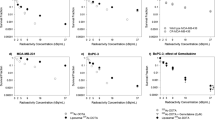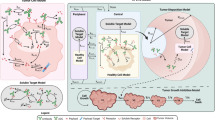Abstract
Many tumours express relatively high levels of low-density lipoprotein (LDL) receptors on their membranes. The LDL receptor is, therefore, an attractive target for the selective delivery of antineoplastic drugs to tumour cells. We reported previously on the synthesis of small apolipoprotein E (apoE)-containing liposomes that behave in vivo in a very similar way to native LDL. In this study, we examined the interaction of this liposomal carrier with cultured B16 melanoma cells. Binding of apoE liposomes to the cells is saturable, with a maximum binding of approximately 90000 particles per cell. Cross-competition studies indicated that apoE liposomes are bound by the LDL receptor. Association of apoE liposomes to B16 cells is strictly Ca2+ dependent, which forms additional evidence for a role of the LDL receptor. The affinity of apoE liposomes for the LDL receptor on B16 cells is 15-fold higher than that of LDL (0.77 vs 11.5 nM respectively). ApoE is essential for the LDL receptor recognition because liposomes lacking apoE were, in competition studies, 20- to 50-fold less effective than apoE-containing liposomes. We examined in B16 tumour-bearing mice the tumour-localizing properties of apoE liposomes and the disposition of an incorporated lipophilic derivative of daunorubicin (LAD). Tissue distribution studies showed that LAD-loaded apoE liposomes were taken up and processed by the major LDL receptor-expressing organs (i.e. adrenals, liver and spleen). Of all other tissues, the tumour showed the highest uptake. The distribution patterns of LAD-loaded apoE liposomes and native LDL in the tumour-bearing mice were very similar, which supports the role of the LDL receptor in the disposition of the prodrug-loaded particles. The disposition of LAD followed the pattern of the liposomal carrier. We conclude that apoE liposomes enable LDL receptor-mediated specific delivery of antineoplastic (pro)drugs to tumours, and, therefore, constitute an attractive novel option for anti-tumour chemotherapy.
Similar content being viewed by others
Author information
Authors and Affiliations
Rights and permissions
About this article
Cite this article
Versluis, A., Rensen, P., Rump, E. et al. Low-density lipoprotein receptor-mediated delivery of a lipophilic daunorubicin derivative to B16 tumours in mice using apolipoprotein E-enriched liposomes. Br J Cancer 78, 1607–1614 (1998). https://doi.org/10.1038/bjc.1998.730
Issue Date:
DOI: https://doi.org/10.1038/bjc.1998.730
- Springer Nature Limited
This article is cited by
-
Impact of lipoproteins on the biological activity and disposition of hydrophobic drugs: implications for drug discovery
Nature Reviews Drug Discovery (2008)
-
Improvement of paclitaxel therapeutic index by derivatization and association to a cholesterol-rich microemulsion: in vitro and in vivo studies
Cancer Chemotherapy and Pharmacology (2005)




